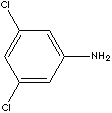| 3,5-DICHLOROANILINE | ||
|
PRODUCT IDENTIFICATION |
||
| CAS NO. | 626-43-7 |
|
| EINECS NO. | 210-948-9 | |
| FORMULA | Cl2C6H3NH2 | |
| MOL WT. | 162.02 | |
| H.S. CODE | ||
|
TOXICITY |
||
| SYNONYMS | 3,5-Dichlorobenzenamine; m-Dichloroaniline; | |
| 1-Amino-3,5-dichlorobenzene; | ||
|
SMILES |
|
|
|
CLASSIFICATION |
|
|
|
PHYSICAL AND CHEMICAL PROPERTIES |
||
| PHYSICAL STATE | white to brown solid | |
| MELTING POINT | 50 - 53 C | |
| BOILING POINT |
261 C | |
| SPECIFIC GRAVITY | 1.58 | |
| SOLUBILITY IN WATER | Insoluble | |
| pH | ||
| VAPOR DENSITY | ||
| AUTOIGNITION |
620 C | |
| NFPA RATINGS | Health: 3; Flammability: 1; Reactivity: 0 | |
| REFRACTIVE INDEX |
||
| FLASH POINT | 133 C | |
| STABILITY | Stable under ordinary conditions. | |
|
DESCRIPTION AND APPLICATIONS |
||
|
Aromatic amines are much weaker bases than the aliphatics. One of the most
important aromatic amines is aniline, a primary aromatic amine replacing one
hydrogen atom of a benzene molecule with an amino group. It is a pale brown
liquid at room temperature; boiling at 184 C, melting at -6 C; slightly soluble
in water and freely soluble in ether and alcohol. It causes serious industrial
poisoning. The substance may have effects on the blood, resulting in formation
of methaemoglobin. Repeated or prolonged exposures may be carcinogenic.
Commercial aniline is obtained from nitrobenzene which is prepared from benzene
with nitric acid by electrophilic substitution reaction or from chlorobenzene by
heating with ammonia in the presence of copper catalyst. It is also obtained as
a by-product of coal tar. In commerce the term of aniline oil blue refers to the
pure one while aniline oil red indicates a mixture of aniline and toluidines with
equimolecular weights.
Considerable quantity of aniline is converted into 4,4��-methylenedianiline (MDA) by the condensation reaction of formaldehyde with aniline in the presence of hydrochloric acid. MDA is is used as an epoxy curing agent, a corrosion inhibitor and molded plastics, and as an intermediate to prepare organic compounds used for polyurethane, spandex fibers, azo dyes, isocyanates and poly(amide-imide) resins. Other important aromatic amine compound as the starting material to produce polyurethane foam production is toluenediamine (TDA). TDA is the mixture of 2,4-diaminotoluene and 2,6-diaminotoluene, usually in a ratio of 80:20. Most of TDA is used in the manufacture of toluene diisocyanate (TDI), which is the predominant diisocyanate in the flexible foams and elastomers industries. TDI reacts with an alcohol to form urethane linkages. Other applications of TDA include to produce dyes, polyamides, antioxidants, hydraulic fluids, and fungicide stabilizers. Aniline is a starting moiety to prepare plant protecting agents. Examples include fenuron (CAS RN: 101-42-8), propham (CAS RN: 122-42-9), siduron (CAS RN: 1982-49-6), carboxin (CAS RN: 5234-68-4), fenfuram (CAS RN: 24691-80-3) and propachlor (CAS RN: 1918-16-7). Aniline is processed to produce a series of compounds being used in the rubber industry, e.g. diphenylguanidines, phenylenediamines mercaptobenzothiazoles, aniline ketones and etc. There are three isomers of phenylenediamine: ortho-, meta-, and para-phenylenediamine. They are low toxic diamines used as components of plastic composites and engineering polymers. They are used to produce aramid fibers, dyes including hair dyes, rubber chemicals (vulcanization accelerators and antioxidants), and pigments. Aniline is the starting material in the dye manufacturing industry. It forms aniline colors when combined with other substances, particularly chlorine or chlorates. Aromatic amines are weaker bases reacting with strong acids to form amides. Anilide is an amide derived from aniline by substitution of an acyl group for the hydrogen of NH2. Acetanilide is from acetic acid and aniline. Acetanilide is an odourless, white flake solid or crystalline powder (pure form); soluble in hot water alcohol, ether, chloroform, acetone, glycerol, and benzene;; melting point 114 C and boiling point 304 C; can undergo self-ignite at 545 C, but is otherwise stable under most conditions. Acetanilide which can be obtained by acetylation of aniline undergoes nitration at low temperature and yields highly the para-nitro products. Acetyl group can then be removed by acid-catalyzed hydrolysis to yield para-nitroaniline. Although the activating affection of the amino group can be reduced, the acetyl derivative remains an ortho/para-orientation and activating substituent. Aniline is converted into sulfanilic acid which is the parent compound of the sulfa drugs. Aniline is also important in the manufacture of rubber-processing chemicals, explosives, plastics, antioxidants and varnishes. Amines take part in many kinds of chemical reactions and offer many industrial applications. 3,5-Dichloroaniline, dichloro-substitued aniline at 3 and 5 positions, is a white-brown solid with aromatic odor; melts at 52 C, boils at 261 C; insoluble in water but readily soluble in most organic solvents. It is used as an intermediate in the production of a number of products, including agricultural chemicals, azo dyes and pigments and pharmaceuticals. |
||
| SALES SPECIFICATION | ||
|
APPEARANCE |
white crystals | |
|
ASSAY |
98.% min | |
|
WATER |
1.0% max | |
| TRANSPORTATION | ||
| PACKING | 240kgs in drum | |
| HAZARD CLASS | 6.1 (Packing group: II) | |
| UN NO. | 1590 | |
| OTHER INFORMATION | ||
|
Hazard
Symbols: T N, Risk Phrases: 23/24/25-33-50/53, Safety Phrases:
28-36/37-45-60-61 Product darkens on storage. |
||
